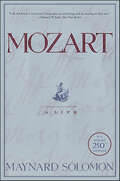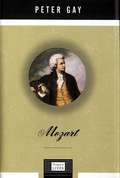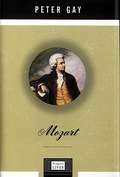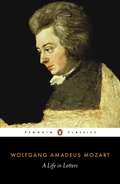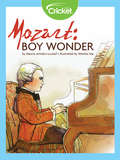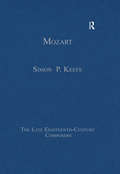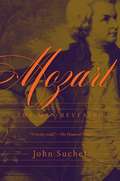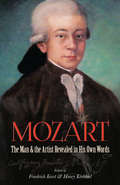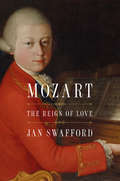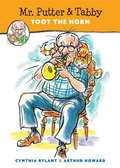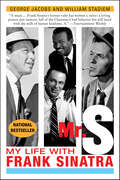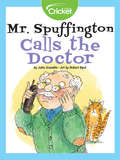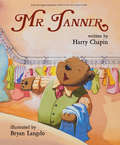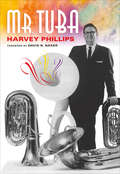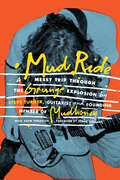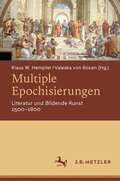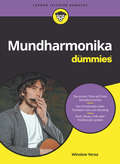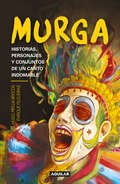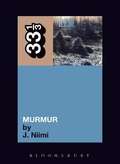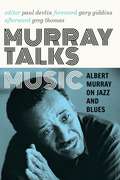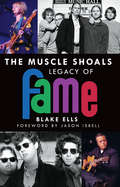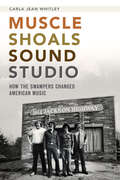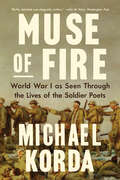- Table View
- List View
Mozart: A Life
by Maynard SolomonOn the occasion of Mozart's two hundred and fiftieth birthday, read Maynard Solomon's Mozart: A Life, universally hailed as the Mozart biography of our time.
Mozart: A Life
by Peter GayMozart's short life (only 35 years) were astoundingly productive. This book tells the story of his life, and provides useful information about his major compositions and associations. There are more comprehensive biographies of Mozart, but this one is not a difficult book to read and will provide enough information to augment the experience of listening to his amazing music.
Mozart: A Life (Grandes Figures, Grandes Signatures Ser.)
by Peter GayA biography of the greatest musical mind in Western history Mozart's unshakable hold on the public's consciousness can only be strengthened by historian and biographer Peter Gay's concise and deft look at the genius's life. Mozart traces the development of the man whose life was a whirlwind of achievement, and the composer who pushed every instrument to its limit and every genre of classical music into new realms. .
Mozart: A Life In Letters
by Wolfgang Amadeus MozartA selection of Mozart's letters, translated into English, complete with notes, linking commentary and chronology.
Mozart: Boy Wonder
by Marcia Amidon LustedWolfgang Amadeus Mozart had amazing talent at a very young age, forever changing the idea of what a child prodigy was.
Mozart: Reception, Work, Completion (The\late Eighteenth-century Composers Ser.)
by SimonP. KeefeThis volume of essays on Wolfgang Amadeus Mozart reflects scholarly advances made over the last thirty years. The studies are broad and focused, demonstrating a large number of viewpoints, methodologies and orientations and the material spans a wide range of subject areas, including biography, vocal music, instrumental music and performance. Written by leading researchers from Europe and North America, these previously published articles and book chapters are representative of both the most frequently discussed and debated issues in Mozart studies and the challenging, exciting nature of Mozart scholarship in general. The volume is essential reading for researchers, students and scholars of Mozart's music.
Mozart: The Man Revealed
by John SuchetThe illustrated life-story of the world’s most beloved composer, bringing vividly to life the man himself, his influences, achievements, and the glittering milieu of the Habsburg empire in eighteenth-century Europe. We think we know the story of Wolfgang Amadeus Mozart's life. Austrian-born to a tyrannical father who worked him fiercely; unhappily married to a spendthrift woman; a child-like character ill at ease amid the aristocratic splendor of the Viennese court; a musical genius who died young thus depriving the world of future glories. Yet only that last point is actually true. In this comprehensive biography, John Suchet examines the many myths and misunderstandings surrounding the world's best-loved composer. From his early days as a child prodigy performing for the imperial royal family in Vienna to the last months of his short life, driven to exhaustion by a punitive workload, one thing remained constant: his happy disposition. Through trials and tribulations, grand successes and disheartening setbacks, Suchet shows us the real Mozart—blessed with an abundance of talent yet sometimes struggling to earn a living. His mischievous nature and earthy sense of humor, his ease and confidence in his own incredible abilities; these were traits that never left him. His music has brought comfort to countless generations; his life, though brief, is no less fascinating.
Mozart: The Man and the Artist Revealed in His Own Words
by Friedrich Kerst Henry KrehbielMozart's adult life was an almost unbroken succession of artistic triumphs and personal disappointments. This collection of excerpts from his letters and from other writings offers a unique opportunity for firsthand insights into the great composer's life and personality.In his own words (as compiled by Friedrich Kerst and translated into English by Henry Edward Krehbiel), Mozart communicates his optimisms and anticipations, his recurrent hopes for a post with a fixed income and suitable prestige; his frequent discouragements when these hopes went unfulfilled and pecuniary difficulties ensued; his unhappiness at Salzburg and his maltreatment at the hands of Archbishop Hieronymus; and the circumstances of his love affair with Aloysia Weber and his subsequent marriage to her sister, Constanze. In all, the book contains 255 observations on such subjects as opera, musical pedagogics, love and friendship, religion and morals, composers and performers, the value of hard work, self-respect and honor, travel, and other matters. Extensive annotations provide background for each excerpt.
Mozart: The Reign of Love
by Jan SwaffordFrom the acclaimed composer and biographer Jan Swafford comes the definitive biography of one of the most lauded musical geniuses in history, Wolfgang Amadeus Mozart.At the earliest ages it was apparent that Wolfgang Mozart’s singular imagination was at work in every direction. He hated to be bored and hated to be idle, and through his life he responded to these threats with a repertoire of antidotes mental and physical. Whether in his rabidly obscene mode or not, Mozart was always hilarious. He went at every piece of his life, and perhaps most notably his social life, with tremendous gusto. His circle of friends and patrons was wide, encompassing anyone who appealed to his boundless appetites for music and all things pleasurable and fun.Mozart was known to be an inexplicable force of nature who could rise from a luminous improvisation at the keyboard to a leap over the furniture. He was forever drumming on things, tapping his feet, jabbering away, but who could grasp your hand and look at you with a profound, searching, and melancholy look in his blue eyes. Even in company there was often an air about Mozart of being not quite there. It was as if he lived onstage and off simultaneously, a character in life’s tragicomedy but also outside of it watching, studying, gathering material for the fabric of his art.Like Jan Swafford’s biographies Beethoven and Johannes Brahms, Mozart is the complete exhumation of a genius in his life and ours: a man who would enrich the world with his talent for centuries to come and who would immeasurably shape classical music. As Swafford reveals, it’s nearly impossible to understand classical music’s origins and indeed its evolutions, as well as the Baroque period, without studying the man himself.
Mozart’s Music of Friends
by Klorman, Edward and McCreless, Patrick Edward Klorman Patrick MccrelessIn 1829 Goethe famously described the string quartet as 'a conversation among four intelligent people'. Inspired by this metaphor, Edward Klorman's study draws on a wide variety of documentary and iconographic sources to explore Mozart's chamber works as 'the music of friends'. Illuminating the meanings and historical foundations of comparisons between chamber music and social interplay, Klorman infuses the analysis of sonata form and phrase rhythm with a performer's sensibility. He develops a new analytical method called multiple agency that interprets the various players within an ensemble as participants in stylized social intercourse - characters capable of surprising, seducing, outwitting, and even deceiving one another musically. This book is accompanied by online resources that include original recordings performed by the author and other musicians, as well as video analyses that invite the reader to experience the interplay in time, as if from within the ensemble.
Mr. Putter And Tabby Toot The Horn (Mr. Putter And Tabby)
by Cynthia Rylant Arthur HowardMr. Putter and his fine cat, Tabby, like sharing music with their neighbors Mrs. Teaberry and her good dog, Zeke. But when Mrs. Teaberry decides they should join a band, Mr. Putter isn’t so sure. He doesn’t even play an instrument--in fact, neither does Mrs. Teaberry. But they aren’t going to let that stop them!
Mr. S: My Life with Frank Sinatra
by William Stadiem George Jacobs"Mr. S: My Life with Frank Sinatra, by former valet-aide George Jacobs with an oh-so-able assist by William Stadiem, has at least five quotable and shocking remarks about the famous on every page. The fifteen years Jacobs toiled for Frank produces a classic of its genre -- a gold-star gossip-lover's dream.... "The rest is showbiz history as it was, and only Ava Gardner, Humphrey Bogart, and Betty Bacall are spared. Marilyn Monroe, Judy Garland, Juliet Prowse, Noel Coward, Cole Porter, Mia Farrow, Elvis Presley, Swifty Lazar, Dean Martin, Peggy Lee, Sammy Davis Jr., Marlene Dietrich, Greta Garbo, Jimmy van Heusen, Edie Goetz, Peter Lawford, and all of the Kennedys come in for heaping portions of 'deep dish,' served hot. Sordid, trashy, funny, and so rat-a-tat with its smart inside info and hip instant analysis that some of it seems too good to be true....
Mr. Spuffington Calls the Doctor
by John GranditsIn this funny story, Mr. Spuffington cuts his finger, bumps his head, and falls asleep in the sun with his cat, Pablo. With each injury, he fears the worst and is quick to call Dr. John. Kids will enjoy learning about how the human body responds to injuries and begins to heal itself.
Mr. Tanner
by Harry ChapinMr. Tanner runs a dry cleaning shop in Dayton, Ohio, where he spends his days greeting his customers with his beautiful baritone voice. His friends and neighbors encourage him to sing professionally instead of cleaning clothes. He eventually takes a chance and travels to New York City to be heard by a concert agent and critics, only to find they weren't hearing what he was feeling. The song Mr. Tanner was released in 1973 off Harry Chapin's Short Stories album. The song was inspired by a mediocre review about a baritone singer in The New York Times. A portion of the proceeds from the sale of this book will go to help support WhyHunger, a charity championed by Harry Chapin himself.
Mr. Tuba
by Harvey PhillipsThe autobiography of &“possibly the greatest tuba player of all time&” (New York Times), the man who &“put class in the low brass.&” (Clark Terry, jazz trumpeter) With warmth and humor, tuba virtuoso Harvey Phillips tells the story of his amazing life and career—from his Missouri childhood through his days as a performer with the King Brothers and the Ringling Bros. and Barnum & Bailey circuses, his training at the Juilliard School, a stint with the U.S. Army Field Band, and his freelance days with the New York City Opera and Ballet. A founder of the New York Brass Quintet, Phillips served as vice president of the New England Conservatory of Music and became Distinguished Professor of Music at Indiana University. The creator of an industry of TubaChristmases, Octubafests, and TubaSantas, he crusaded for recognition of the tuba as a serious musical instrument, commissioning more than 200 works. Enhanced by an extensive gallery of photographs, Mr. Tuba conveys Phillips&’s playful zest for life while documenting his important musical legacy. &“Mr. Tuba is not only a memoir, but it is a history of the twentieth century American music world and a resource for all music teachers and music lovers.&” —NBA Journal &“A lively and informative read.&” —Herald-Times &“[Phillips&’s] autobiography is a fitting end to his life&’s works, underlined with the same sense of inspiration and integrity that informed all of his musical activities.&” —Bloom Magazine
Mud Ride: A Messy Trip Through the Grunge Explosion
by Steve Turner Adem TepedelenA down-and-dirty chronicle of the birth and evolution of the Seattle grunge scene—from amateur skate parks and underground hardcore clubs to worldwide phenomenon—as told by one of its founding fathers and lead guitarist of legendary alternative rock band, Mudhoney.In the late 80s and early 90s, Steve Turner and his friends—Seattle skate punks, hardcore kids, and assorted misfits—started forming bands in each other’s basements and accidentally created a unique sound that spread far beyond their once-sleepy city. Mud Ride offers an inside look at the tight-knit grunge scene, the musical influences and experiments that shaped the grunge sound, and the story of Turner's bands, Green River and Mudhoney, which went from underground flophouse shows to selling out stadiums with Nirvana and Pearl Jam. Including stories about the key moments, musicians, and albums from grunge's beginnings to its come-down from the highs of global success and stardom, this is the first account of the musical phenomenon that took over the world from someone who was there for it all. Written by Steve Turner, lead guitarist of Mudhoney, a foundational grunge band that inspired musical icons from Kurt Cobain to Sonic Youth, Mud Ride features a foreword by Pearl Jam's Stone Gossard and never-before-seen photographs and grunge memorabilia throughout. Take a seat and ride through the messy and muddy grunge scene that grew from the basements of the Northwest and went on to circle the globe.MUST HAVE FOR FANS: For cult fans of Mudhoney and all things Seattle grunge, this is the perfect book to add to your collection. Turner helped put Sub Pop Records on the map, a label that launched bands like Soundgarden and more. Mudhoney was also one of the first American grunge bands to tour Europe and the UK, laying the groundwork for the worldwide explosion of grunge. Learn more about the ins and outs of the birth of grunge and immerse yourself in '80s and '90s Seattle.A GREAT GIFT FOR MUSIC LOVERS: For the aspiring musician or anyone wanting to learn more about music history, this is an illuminating look into grunge and Seattle bands that have gone on to become world-famous. AN ESSENTIAL ROCK HISTORY BOOK: An amazing gift for readers of Legs McNeil and Gillian McCain's Please Kill Me, John Doe and Tom DeSavia's Under the Big Black Sun, and Michael Azerrad's Our Band Could Be Your Life. Anyone wanting to learn more about the history of grunge will delight in this great tell-all read.Perfect for:Music lovers, history buffs, and musiciansFans of Pearl Jam, Nirvana, Hole, Green River, and moreAnyone nostalgic for the '80s and '90s pop culture scenePeople obsessed with grunge, rock, musical movements, or Seattle historyReaders of Please Kill Me, Under the Big Black Sun, Our Band Could Be Your Life, Grunge Is Dead, and Everybody Loves Our Town: An Oral History of GrungeGen Z readers who have embraced all things '90s, from the decade's fashion to its music, and have sparked a resurgence in popularity of grunge bands like Nirvana
Multiple Epochisierungen: Literatur und Bildende Kunst 1500–1800
by Klaus W. Hempfer Valeska Von RosenEntgegen einer pauschalen Kritik an den Epochenbegriffen diskutieren die Beiträge des vorliegenden Bandes historische und systematische Bedingungen der Möglichkeit von Epochisierungen. Unterschiedliche sozio-kulturelle Systeme werfen unterschiedliche Fragen auf. Als Literatur- und Kunstwissenschaftler/innen gehen die Beiträgerinnen und Beiträger von Problemkomplexen ihrer jeweiligen Disziplinen aus, rekurrieren für Lösungsansätze aber auch auf das Theorieangebot anderer historischer Disziplinen wie der Geschichtswissenschaft im Allgemeinen oder der Wissenschaftsgeschichte im Besonderen. - Insgesamt ergibt sich, dass die berechtigte Kritik an der spezifischen Faktur spezifischer Epochisierungen weder aus systematischen noch historischen Gründen den generellen Verzicht auf Epochisierungen nahelegt. Solange kein konsistentes Gegenmodell vorliegt, kann es nur darum gehen, Epochentheorie allgemein und Theorien der jeweiligen Einzelepochen im Zusammenhang zu optimieren.
Mundharmonika für Dummies (Für Dummies)
by Winslow YerxaDas Buch konzentriert sich auf die diatonische Mundharmonika mit zehn Tonkanälen. Es bietet einen allgemeinen Überblick über das Instrument und darüber, was man als Spieler mitbringen sollte. Behandelt wird auch, was man beim Kauf einer Mundharmonika beachten muss, wie man richtig sowohl Akkorde als auch einzelne Töne spielt, die Bending-Technik zum "Biegen" der Töne, diverse Spieltechniken und Tipps, sowie das Spielen in einer Band oder einem Duo. Dabei hilft eine Grifftabelle, die für jede Übung anzeigt, wo die Finger hinmüssen. Der Autor erklärt außerdem, wie man seine Mundharmonika reparieren oder sogar im Klang verbessern kann und gibt Empfehlungen zu verschiedenen Mundharmonika-Alben.
Murga: Historias, personajes y conjuntos de un canto indomable
by Hugo Brocos Enrique FilgueirasEl libro que recorre la historia de uno de los fenómenos culturales e identitarios del Uruguay: la murga. Este trabajo presentado de forma organizada, ágil y entretenida logra -con la fuerza de un coro de murga- cantarnos una historia: una historia de personajes, conjuntos y por qué no de un país. ¿Cómo se compone una murga? ¿Qué rol juega cada integrante arriba y abajo del escenario? ¿Qué compone estrictamente un espectáculo murguero? Son algunas de las preguntas que tendrán respuesta en estas páginas. También, a lo largo de este texto, se podrá recorrer la historia y la evolución de la murga desde La Gaditana que se va a principios del Siglo XX hasta la irrupción de la murga joven como fenómeno y la murga en pleno Siglo XXI; las principales figuras que ayudaron a construir la identidad del género como Tito Pastrana, Pepino, Cachela, pasando por Pepe Veneno, Catusa Silva hasta los referentes actuales, para finalmente recorrer la historia de los conjuntos más importantes y que dejaron y dejan huella en el carnaval uruguayo: Don Bochinche y Compañía, Patos Cabreros, Curtidores de Hongos, Araca la Cana, La Soberana, Los Arlequines, La Reina de la Teja, Falta y Resto entre muchas otras. Un libro fundamental para los amantes de la murga y para aquellos que quieran conocer parte de la historia y la identidad de un país.
Murmur (33 1/3 Ser. #22)
by J. NiimiR.E.M.'s debut album, released in 1983, was so far removed from the prevailing trends of American popular music that it still sounds miraculous and out of time today. J. Niimi tells the story of the album's genesis - with fascinating input from Don Dixon and Mitch Easter. He also investigates Michael Stipe's hypnotic, mysterious lyrics, and makes the case for Murmur as a work of Southern Gothic art.
Murray Talks Music: Albert Murray on Jazz and Blues
by Albert MurrayThe year 2016 will mark the centennial of the birth of Albert Murray (1916–2013), who in thirteen books was by turns a lyrical novelist, a keen and iconoclastic social critic, and a formidable interpreter of jazz and blues. Not only did his prizewinning study Stomping the Blues (1976) influence musicians far and wide, it was also a foundational text for Jazz at Lincoln Center, which he cofounded with Wynton Marsalis and others in 1987. Murray Talks Music brings together, for the first time, many of Murray&’s finest interviews and essays on music—most never before published—as well as rare liner notes and prefaces.For those new to Murray, this book will be a perfect introduction, and those familiar with his work—even scholars—will be surprised, dazzled, and delighted. Highlights include Dizzy Gillespie&’s richly substantive 1985 conversation; an in-depth 1994 dialogue on jazz and culture between Murray and Wynton Marsalis; and a long 1989 discussion on Duke Ellington between Murray, Stanley Crouch, and Loren Schoenberg. Also interviewed by Murray are producer and impresario John Hammond and singer and bandleader Billy Eckstine. All of thse conversations were previously lost to history. A celebrated educator and raconteur, Murray engages with a variety of scholars and journalists while making insightful connections among music, literature, and other art forms—all with ample humor and from unforeseen angles.Leading Murray scholar Paul Devlin contextualizes the essays and interviews in an extensive introduction, which doubles as a major commentary on Murray&’s life and work. The volume also presents sixteen never-before-seen photographs of jazz greats taken by Murray.No jazz collection will be complete without Murray Talks Music, which includes a foreword by Gary Giddins and an afterword by Greg Thomas.
Muscle Shoals Legacy of FAME, The
by Blake Ells Jason IsbellFAME Publishing first opened in 1959 and produced hits for great musicians like Etta James, Clarence Carter and Aretha Franklin. Not long after, the city of Muscle Shoals became known as the "Hit Recording Capital of the World." FAME was the foundation that produced Muscle Shoals Sound Studio, the Nutthouse and Sundrop Sound at Single Lock Records--studios that gave a voice to artists like Drive-By Truckers, Jason Isbell and the 400 Unit and John Paul White. A new generation, including the Pollies and Doc Dailey & the Magnolia Devil, today carries the tradition of great music. Through extensive research, and enriched with interviews from those who lived it, local author Blake Ells chronicles the epic story that started with FAME.
Muscle Shoals Sound Studio: How the Swampers Changed American Music (Music Ser.)
by Carla Jean WhitleyThe chronicle of the legendary Alabama studio brings to life decades of rock, blues, and R&B history from The Rolling Stones to The Black Keys. An estimated four hundred gold records have been recorded in the Muscle Shoals area. Many of those are thanks to Muscle Shoals Sound Studio and the session musicians known as the Muscle Shoals Rhythm Section—also dubbed &“the Swampers.&” Some of the greatest names in rock, R&B and blues laid tracks in the original, iconic concrete-block building, including Cher, Lynyrd Skynyrd, and scores of others. The National Register of Historic Places now recognizes that building, where Lynyrd Skynyrd recorded the original version of &“Free Bird&” and the Rolling Stones wrote &“Brown Sugar&” and &“Wild Horses.&” By combing through decades of articles and music reviews related to Muscle Shoals Sound, music writer Carla Jean Whitley reconstructs the fascinating history of how the Alabama studio created a sound that reverberates across generations.
Muse of Fire: World War I as Seen Through the Lives of the Soldier Poets
by Michael KordaThe First World War comes to harrowing life through the intertwined lives of the soldier poets in Michael Korda’s epic Muse of Fire. Michael Korda, the best-selling author of Hero and Alone, tells the story of the First World War not in any conventional way but through the intertwined lives of the soldier poets who came to describe it best, and indeed to symbolize the war’s tragic arc and lethal fury. His epic narrative begins with Rupert Brooke, “the handsomest young man in England” and perhaps its most famous young poet in the halcyon days of the Edwardian Age, and ends five years later with Wilfred Owen, killed in action at twenty-five, only one week before the armistice. With bitter irony, Owen’s mother received the telegram informing her of his death on November 11, just as church bells tolled to celebrate the war’s end. Korda’s dramatic account, which includes anecdotes from his own family history, not only brings to life the soldier poets but paints an unforgettable picture of life and death in the trenches, and the sacrifice of an entire generation. His cast of characters includes the young American poet Alan Seeger, who was killed in action as a private in the French Foreign Legion; Isaac Rosenberg, whose parents had fled czarist anti-Semitic persecution and who was killed in action at the age of twenty-eight before his fame as a poet and a painter was recognized; Robert Graves and Siegfried Sassoon, whose friendship and friendly rivalry endured through long, complicated private lives; and, finally, Owen, whose fame came only posthumously and whose poetry remains some of the most savage and heartbreaking to emerge from the cataclysmic war. As Korda demonstrates, the poets of the First World War were soldiers, heroes, martyrs, victims, their lives and loves endlessly fascinating—that of Rupert Brooke alone reads like a novel, with his journey to Polynesia in pursuit of a life like Gauguin’s and some of his finest poetry written only a year before his tragic death. Muse of Fire is at once a portrait of their lives and a narrative of a civilization destroying itself, among the rubble, shadows, and the unresolved problems of which we still live, from the revival of brutal trench warfare in Ukraine and in the Middle East.
